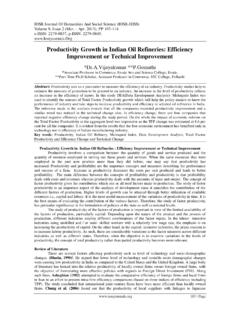Transcription of The relative e˜ciency of public and private service delivery
1 The relative e ciency of public and private service deliveryJustine Hsu World Health Report (2010)Background Paper, 39 The path to universal coverageHEALTH SYSTEMS FINANCING World Health Organization, 2010 All rights reserved. The designations employed and the presentation of the material in this publication do not imply the expression of any opinion whatsoever on the part of the World Health Organization concerning the legal status of any country, territory, city or area or of its authorities, or concerning the delimitation of its frontiers or boundaries.
2 Dotted lines on maps represent approximate border lines for which there may not yet be full agreement. The mention of specific companies or of certain manufacturers' products does not imply that they are endorsed or recommended by the World Health Organization in preference to others of a similar nature that are not mentioned. Errors and omissions excepted, the names of proprietary products are distinguished by initial capital letters. All reasonable precautions have been taken by the World Health Organization to verify the information contained in this publication.
3 However, the published material is being distributed without warranty of any kind, either expressed or implied. The responsibility for the interpretation and use of the material lies with the reader. In no event shall the World Health Organization be liable for damages arising from its use. The findings, interpretations and conclusions expressed in this paper are entirely those of the author and should not be attributed in any manner whatsoever to the World Health Organization. The relative efficiency of public and private service delivery World Health Report (2010) Background Paper, No 39 Justine Hsu1 1 London School of Hygiene and Tropical Medicine, London, the United Kingdom 2 public and private roles The relative roles of the public and privateb sectors in healthcare provision have and continue to evolve over time.
4 Reforms stem back to 19th century neoclassical economics that market solutions lead to more efficient allocation of resources, uncertainties over how the healthcare market would respond to these institutions1 2 and, more recently, to new public management theories3 and the influence of multilaterals4 5. The debate over the relative merits of private and public provision seeks to answer the question who would more efficiently provide public goods? Proponents of private provision cite the duality of profit maximisation and efficiency as theoretical evidence of its advantage.
5 The competitive market model is argued for potential gains in efficiency , quality, consumer choice and responsiveness, and transparency and accountability6. However, arguments against private provision cite failures inherent in the healthcare market and a mismatch between public health orientation and profit maximisation. Ultimately, as Culyer7 argued, empirical evidence should assist in answering the question of which institution most efficiently provides services . This brief seeks to broadly assess the relative efficiency of public and private delivery in healthcare.
6 It summarises empirical evidence, identifies factors that influence efficiency and outlines policy implications. The evidence-base is limited but growing. Findings are mixed which suggest that efficiency gains in private delivery depend on the context. What is efficiency and why is important? The World Health Report 2000 called attention to the importance of efficiency in all functions of a health system and in ultimately achieving the goals of health improvement, responsiveness and fairness in financing8.
7 Technical efficiency refers to the extent that resources are being wasted. It measures the degree of producing the maximum amount of outputs from a given amount of inputs or, conversely, using the minimum amount of inputs to produce a given output9. Examples of inefficiencies are excessive hospital length of stay, over-prescribing, over-staffing, use of branded over generic drugs, and wastage of stock. It has thus been analogized to a torn rice sack10 as resources are wasted due to inefficiencies in the system.
8 Measurement of efficiency is especially relevant in settings constrained by scarce resources and given the recent economic downturn and escalating healthcare costs. It allows a system to produce more and better at zero cost. b Use of the term private refers to private for-profits and private not-for-profits ( non-governmental organisations, faith-based organisations, charitable organisations), and privately motivated individual(s). 3 Empirical evidence The efficiency of the hospital sector merits analysis as it represents the largest proportion of total health expenditure in OECD countries11 and approximately 45-69% of government health expenditure in sub-Saharan Africa12.
9 frontier efficiency measurementsc of public and private provision in hospitals and similar healthcare settings is summarised below. This selective review provides insight into how efficiency varies with ownership and highlights the diversity across environments. Hollingsworth13 14 15 conducted a meta- analysis of 317 published works on efficiency measures and concludes that public provision may be potentially more efficient than private d. Summary statistics showed average for-profit hospital efficiency levels at , not-for-profit at , and public at In other words, hospitals could increase outputs by 20% with current levels of inputs or, alternatively, reduce inputs by 20% while still maintaining its current levels of outputs.
10 Taking a few countries as examples, it is evident that the impact of ownership on efficiency is mixed. Lee et al16 determined that non-profit hospitals in the United States were more efficient than for-profit hospitals, and earlier studies validate this conclusion17 18 19 20 21 22. In contrast, Chang et al23 found the private sector to be more efficient than the public sector in Taiwan. Swiss hospitals efficiency levels were not predisposed towards inefficiency by type of ownership24 25 26 27. Finally, in Germany, evidence is mixed. Herr28 and Helmig & Lapsley29 found private hospitals less technically efficient than publicly owned hospitals.











